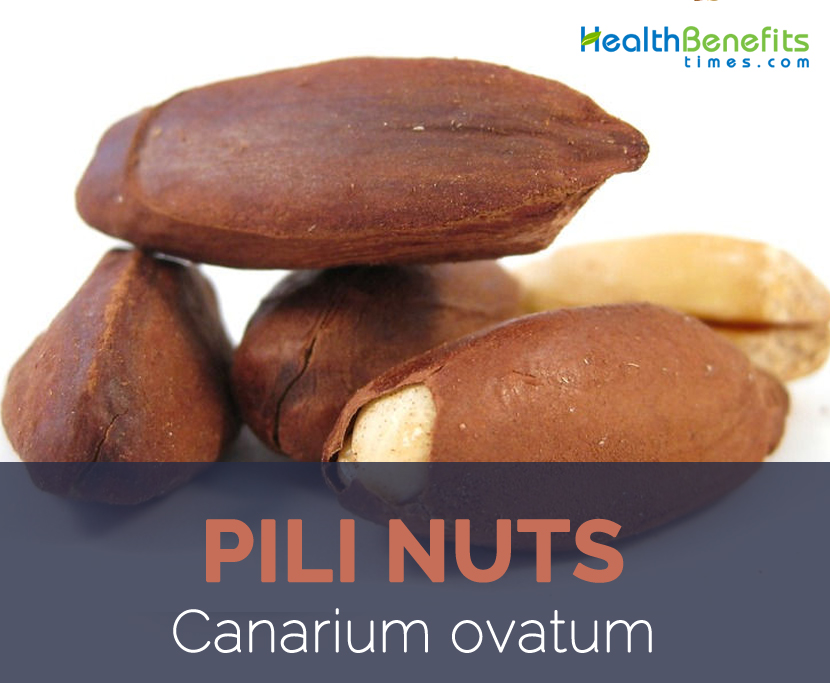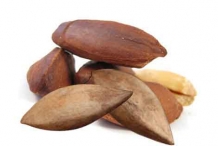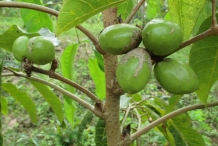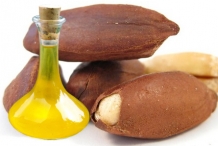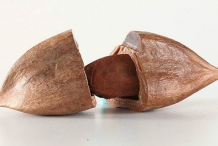Plant
Canarium ovatum, commonly known as pili is actually a tall, attractive symmetrical, resinous-wood trees, 20 m (66 ft.) tall and 50 cm in diameter. Plant is normally found growing in warm temperature with even rainfall. They cannot resist even a small amount frost neither low temperature. It grows well on both light and heavy soils and prefers deep, fertile, well-drained soil. Trunk has diameter of 50 centimeters or more. Leaves are compound and arranged on either side, typically in pairs opposite each other. Leaves have deltoid to lingulate stipules, spirally arranged, imparipinnate, about 40 centimeters long. Leaflets are ovate to elliptic, 4 to 24 centimeters long and 2 to 12 centimeters wide, stiff-coriaceous, entire, base oblique, rounded to sub cordate, apex acuminate with 8 to 12 pairs of nerves. Similarly flowers are whitish yellow in color. It is 3-merous, unisexual, sub sessile, pubescent, up to 12 mm long; calyx cupular, 7 mm long in male, 8-9 mm in female flowers; petals 2 cm × 1 cm; stamens 6, slightly adnate to the disk in male, inserted on the rim of the disk and sterile in female flowers; pistil absent in male flowers, in female ones 7 mm long, ovary 3-locular, style 1.5 mm, stigma 3-lobed.
Fruit
Canarium ovatum is a drupe, 4-7 cm (1.6 to 2.8 in) long and 2.3 to 3.8 cm (0.91-1.50 in) diameters, typically in a teardrop shape, and weight up to 15.7 to 45.7g (0.035-0.101 lb.). The skin (exocarp) is smooth, thin, shiny, and turning from light green to purplish black after the fruit ripens: the pulp (mesocarp) is fibrous, fleshy, and greenish yellow in color and the hard shell (endocarp) within protects a normally dicotyledonous embryo. It is elongated, stony, trigonous, pointed at base, blunt or obtuse at apex, tawny to dirty brown, sterile cells strongly reduced. Seed with 1 brown papery seed coat. Much of the kernel weight is made up of the cotyledons, which are about 4.1-16.6% of the whole fruit. This fruit has a sweet and nutty flavor and rich buttery taste like pumpkin seeds. Pili is a well adaptable nut which can be used for many number of products, the nut plays an important role of all. The nut can be either consumed raw else roasted giving it a mild, tender, crispy structure which could be bought in comparison of almonds having a little more superior taste than that of them. These are also main constituents of chocolate, ice cream and baked goods.
History
It is said that cultivation of Pili nut started from the tropical rainforest of Philippines. The ancient people of Philippines collected the nuts which were growing wild in the forest and boiled them to make it edible. Gradually the native people started growing them domestically for food. Later on it was planted throughout the world because of its higher nutritional value and health promoting benefits.
Nutritional Value
Apart from their rich buttery taste, pili nuts are a good source of nutrients, vitamins and minerals. Consuming 120 gram of pili nuts offers 95.46 g of Total Fat, 1.15 mg of Copper, 2.776 mg of Manganese, 690 mg of Phosphorus, 1.096 mg of Vitamin B1, 362 mg of Magnesium, 4.24 mg of Iron, 3.56 mg of Zinc, 72 µg of Vitamin B9 and 174 mg of Calcium. Moreover many Amino acids 0.227 g of Tryptophan, 0.488 g of Threonine, 0.58 g of Isoleucine, 1.068 g of Leucine, 0.443 g of Lysine, 0.474 g of Methionine and 0.227 g of Cystine are also found in 120 gram of pili nuts.
Health benefits of Pili Nuts
Pili nut is a wonderful source of important nutrients, minerals and vitamins and they have proven to have many health benefits in us. Health benefits of pili nuts include Improve Cognition, Treat anemia, Promotes Heart Health, Diabetic Aid, Bone Health, Lower high blood pressure, Digestive Issues, Weight Loss, Overcome Insomnia, Promotes Skin And Hair Health, Inflammation, Sleep Aid, Energy Booster, Prevents Tongue Inflammation, Chronic Disease, Immune System Strength, Cholesterol Balance and Proper Development and Growth
1. Improve Cognition
Omega-3 fatty acids are linked to reducing inflammation in neural pathways that may improve concentration and focus. Additionally, the antioxidants found in pili nuts can also eliminate the oxidative stress that can speed up neural degeneration and also lead to disorders like Alzheimer’s and dementia. Including these nuts can keep your brain firing on all cylinders well into your older years.(1)
2. Treat anemia
Anemia is actually a low level of hemoglobin in the blood. It makes us look very pale, and we get tired very easily. We also might suffer from difficulty in breathing because of insufficient hemoglobin. Severe anemia can also lead to heart failure.
Sufficient intake of iron rich foods is a necessity to prevent and treat iron deficiency anemia. Pili nuts are a good source of iron. They help in treating anemia by helping in the formation of hemoglobin.
3. Promotes Heart Health
Pili Nuts are wonderful source of heart-healthy omega fatty acids. Pili nuts contain all the important omega fatty acids, which not only improve blood circulation, but also decrease the risk of you contracting cardiovascular disease. The American Heart Association urges people with heart problems to have food rich in omega fatty acids, which makes pili nuts a highly desirable foodstuff.(2)
4. Diabetic Aid
Pili Nuts consists of all eight amino acids which makes them particularly beneficial for those suffering from diabetes, or those at high risk for developing the condition. Apart from that these nuts help balance blood glucose levels, and ensure that the body is releasing insulin at appropriate times and in appropriate amounts. This will avoid the dangerous peaks and drops of diabetic patients.
5. Bone Health
Pili nuts consist of diverse mix of minerals which are quite beneficial for our bones. Bone mineral density naturally begins to decline as we grow old, so it is important to increase our mineral intake, or at least ensure that it is in line with daily requirements. Pili nuts offer zinc, calcium, magnesium, copper, manganese and phosphorous, many of which are important to keeping our bones strong, particularly as we age.
6. Lower high blood pressure or hypertension
Sodium is a mineral that leads to preservation of water in the body that uplifts the blood pressure. Pili nuts have low levels of sodium which helps in avoiding the sudden rise of blood pressure. They also comprise numerous other essential minerals which help to maintain normal blood pressure.
Magnesium is a mineral that plays an important role in the relaxation of blood vessels. Pili nuts are rich in magnesium. They relax the blood vessels and lower the high blood pressure levels. They help in avoiding all the complications of hypertension like damage to kidneys, nerves, eyes, heart and brain.
7. Digestive Issues
Pili nuts are outstanding for optimizing your digestion and improving gastrointestinal health. The natural fibers present in pili nuts help stimulates peristaltic motion and avoid constipation and hemorrhoids. This can help you improve the efficiency of your nutrient uptake, which means maximizing the value of the food you consume!(3)
8. Weight Loss
Pili nuts can help you lose weight due to the healthy cholesterol balance and the fiber found in these nuts. Nuts of almost all kinds are outstanding ways to suppress hunger, as fiber makes the body feel that it is full, therefore reducing your chances of going to the pantry for yet another midnight snack. The cholesterol-balancing effects can improve metabolic effectiveness, which means body will begin to burn fat more quickly and efficiently.(4)
9. Overcome Insomnia
Pili nuts can help to overcome insomnia as well as other sleep deprived disorders. Well, pili nuts are rich in several essential minerals, and one of them is magnesium. They actually contain the highest magnesium content of any nut. This property makes pili nuts an excellent cure for insomnia as magnesium treats the symptoms of insomnia and helps you sleep better at night.(5)
10. Promotes Skin and Hair Health
Vitamin E found in pili nuts helps improve skin and hair quality. Vitamin E helps protect your body against many conditions like cholesterol sediments, and even stimulates antioxidants. Pili Nuts are the richest source of vitamin E among all nuts, which is why they help promote your skin and hair health.(6)
11. Inflammation
Pili nuts are natural anti-inflammatory substances because they consist of rich amounts of antioxidants. Antioxidants mostly eliminate free radicals, which can cause oxidative stress and increase inflammation throughout the body. By including pili nuts to your diet, you can cut down on inflammatory conditions like arthritis and gout, among many others.(7)
12. Sleep Aid
Magnesium is an important component of serotonin and other relaxing hormones that can prevent symptoms of insomnia and sleeplessness. If you find that you infrequently get a full, restful night of sleep, then high levels of magnesium found in pili nuts may be exactly what your body needs to find relief.(8)
13. Energy Booster
Pili nuts is one of the best nuts that ensure the body can energize itself, produce new tissues, and run all of its organ systems at optimal levels. The mixture of minerals, proteins and carbohydrates also drives energy levels up. Even a handful of these nuts can give you an energetic surge.(9)
14. Prevents Tongue Inflammation
Folic acid or Vitamin B9 is one of the most essential B-vitamins essential for our body. Tongue inflammation, or glossitis, isn’t a painful condition and is frequently caused due to the lack of folate in the diet. As Pili Nut is one of the richest sources of Vitamin B9, it helps prevent and even help cure glossitis. Therefore, having Pili Nut is one of the best ways to maintain healthy folate levels.
15. Chronic Disease
As mentioned before, antioxidants are exceptional for reducing free radical damage and oxidative stress, which frequently leads to chronic diseases, even cancer. The diverse mix of antioxidants found in pili nuts keep body’s systems operating efficiently and neutralize those dangerous byproducts of cellular metabolism before they can cause healthy cells to mutate or malfunction.(10)
16. Immune System Strength
Antioxidants give our immune system a break by decreasing the strain to continually fight off body-weakening disease and stress. However, these tropical nuts help our immune system in another way as well. The high levels of vitamin E are also directly associated with giving the immune system a boost, and making sure that you stay healthy!(11)
17. Cholesterol Balance
Remarkable amount of fats found in pili nuts may make some people think that they would be bad for your cholesterol levels, but it is important to remember that not all fats are bad. In fact, omega-3 fatty acids, which are found in good supply within pili nuts, help to balance cholesterol levels and eliminate additional omega-6 fatty acids. This can lower your risk for heart conditions like atherosclerosis, and prevent heart attacks and strokes.(12)
18. Proper Development and Growth
Proteins are the building blocks of life for human beings, and pili nuts contain an adequate amount to earn it some praise. We need proteins for everything from organ development and muscle growth to healing and metabolic activity. Including a protein-rich nut to your diet is therefore never a bad idea.(13)
How to Eat
- Pili are used in candies and brittle in Philippines.
- Kernels are used for making cake, bobengka in Minahasan or bubengka in Maluku in Indonesia, especially in Minahasa and Moluccas islands.
- Pili kernel is used in chocolate, ice cream, and baked goods.
- Kernel is one of the major ingredients in one type of the famous Chinese festive desserts known as the “moon cake”.
- Shoots are used in salads.
- Pulp is eaten after it is boiled and seasoned.
- Green shoots can be added to salads, along with other plants and vegetables.
- Shoots and the pulp can be pickled but also added as an ingredient in sauces or purees.
- Stir them into yogurt or hot cereal to add a nutty flavor and a bit of crunch.
- Toss pili nuts with granola or mix them into homemade bread batter.
- Make a smoothie with cacao, coconut milk, vanilla and chopped pili nuts.
Other Traditional uses and benefits of Pili Nuts
- It is traditionally used to de-worm livestock and used to treat skin diseases in humans like scabies.
Other Facts
- Pulp oil can be extracted and used for cooking or as a substitute for cotton seed oil in the manufacture of soap and edible products.
- Stony shells are excellent as fuel or as porous, inert growth medium for orchids and anthurium.
- Tree’s sap is used for igniting fire, substituting gasoline.
- Pili tree produces sticky flammable organic substance which is insoluble in water used for making Plastics and inks.
- Pili nut oil is used to manufacture cosmetic, soaps and shampoo including pharmaceutical and industrial products.
- Shell of the nuts makes good cooking fuel and can be made into attractive ornaments.
- Shell is used for manufacturing fashion accessories.
- Wood is used to make furniture.
References:
https://en.wikipedia.org/wiki/Canarium_ovatum
http://www.fruitsinfo.com/pili-nut.php
http://www.jempastries.com/Pili-Nut.htm
http://veggiesinfo.com/pili-nuts-nutrition-facts/
http://www.healthybite.net/artical/57/
http://www.herbs2000.com/herbs/herbs_pili_nut.htm
http://www.onlyfoods.net/pili-nut.html
https://hort.purdue.edu/newcrop/CropFactSheets/PiliNut.html
http://www.stuartxchange.org/Pili.html
https://en.wikipedia.org/wiki/Canarium
http://www.worldagroforestry.org/treedb/AFTPDFS/Canarium_ovatum.PDF
http://uses.plantnet-project.org/en/Canarium_ovatum_(PROSEA)
http://trendydamsels.com/pili-nuts/
http://plants.findthedata.com/l/2348/Canarium-ovatum-Engl-Pili-Nut
https://training.ars-grin.gov/gringlobal/taxonomydetail.aspx?id=8819
https://anthrome.files.wordpress.com/2008/03/pilinut.pdf
http://davesgarden.com/guides/pf/go/178794/
https://npgsweb.ars-grin.gov/gringlobal/taxonomydetail.aspx?id=8819
Comments
| Pili Nuts Quick Facts | |
|---|---|
| Name: | Pili Nuts |
| Scientific Name: | Canarium ovatum |
| Origin | Maritime Southeast Asia (Indonesia, Malaysia, and the Philippines), Papua New Guinea, and Northern Australia. |
| Colors | Turning from light green to purplish black after the fruit ripens |
| Shapes | Drupe with a length of 4-7 cm (1.6 to 2.8 in) and 2.3 to 3.8 cm (0.91-1.50 in) diameters, typically in a teardrop shape. |
| Flesh colors | Greenish yellow |
| Taste | Rich buttery taste |
| Calories | 863 Kcal./cup |
| Major nutrients | Total Fat (272.74%) Copper (127.78%) Manganese (120.70%) Phosphorus (98.57%) Vitamin B1 (91.33%) |
| Health benefits | Improve Cognition, Treat anemia, Promotes Heart Health, Diabetic Aid, Bone Health, Lower high blood pressure, Digestive Issues, Weight Loss, Overcome Insomnia, Promotes Skin And Hair Health, Inflammation, Sleep Aid, Energy Booster, Prevents Tongue Inflammation, Chronic Disease, Immune System Strength, Cholesterol Balance, Proper Development and Growth |
| More facts about Pili Nuts | |
| Rank | Scientific Name & (Common Name) |
|---|---|
| Kingdom | Plantae (Plantes, Planta, Vegetal, plants) |
| Subkingdom | Viridiplantae |
| Infrakingdom | Streptophyta (Land plants) |
| Superdivision | Embryophyta |
| Division | Tracheophyta (Vascular plants, tracheophytes) |
| Subdivision | Spermatophytina (Spermatophytes, seed plants, phanérogames) |
| Class | Magnoliopsida |
| Superorder | Rosanae |
| Order | Sapindales |
| Family | Burseraceae (Burseras) |
| Genus | Canarium L. |
| Species | Canarium ovatum Engl. (Pili nut) |


